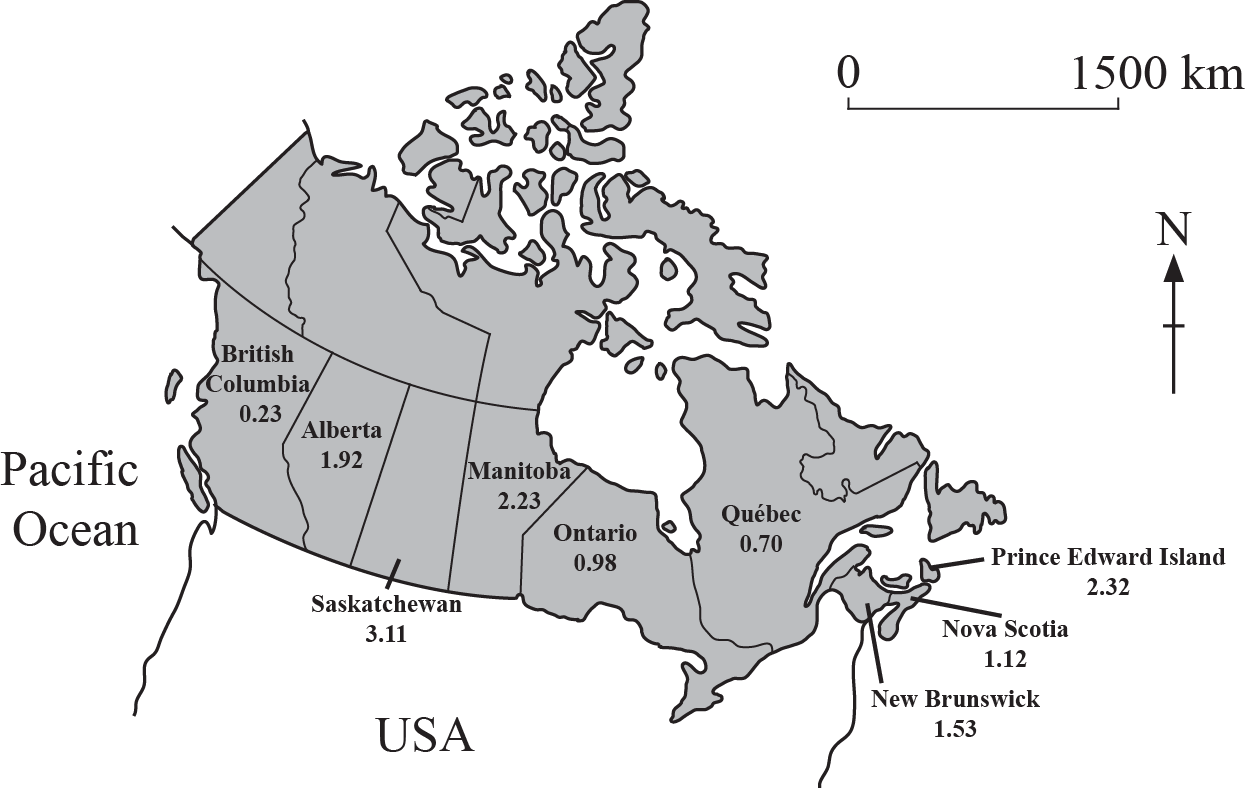| Date | May 2012 | Marks available | 3 | Reference code | 12M.2.bp.12 |
| Level | SL and HL | Paper | 2 | Time zone | |
| Command term | Describe | Question number | 12 | Adapted from | N/A |
Question
The map shows the energy efficiency ratios for agriculture in selected provinces in Canada.

[Source: adapted from T McRae, CAS Smith and LJ Gregorich (eds.), (2000), Environmental Sustainability of Canadian Agriculture: Report of the Agri-Environmental Indicator Project. A Summary. Ottawa: Agriculture and Agri-Food Canada]
Identify the province with the most efficient energy ratio.
Describe the pattern of energy efficiency ratios shown on the map.
Suggest three reasons why energy efficiency ratios vary within a country or region.
Examine recent changes in agricultural systems that have led to increased food availability in some areas.
Markscheme
Saskatchewan.
The lowest (least efficient) energy efficiency ratio is in British Columbia; the highest (most efficient) ratio is in Saskatchewan. Larger provinces (in area) tend to have lower ratios than smaller provinces, but overall there is not a very clear pattern. The eastern seaboard has medium to high values; the lowest value is on the west coast.
The overall pattern is of distance decay from Saskatechewan with the provinces in eastern Canada representing an anomaly. Award 1 mark each for any valid statements.
Energy ratios depend on numerous factors, including the technology employed in agriculture (for example, glasshouses are much less efficient than open field farming); methods of cultivation (generally, subsistence farming is more energy efficient than commercial farming); the precise crop(s) grown (for example, growing peas has a lower energy ratio than growing wheat or maize); the climate (energy ratios are often more efficient in warmer, wetter areas, than in cooler, drier areas, because of differences in biological productivity); the soil type (which also results in different yields or levels of productivity).
Award 1 mark for each reason stated (provided it links to energy efficiency) and 1 mark for further development.
Candidates may interpret the term “agricultural systems” in its narrowest sense, or may adopt a more inclusive definition, to include technological innovations and changes to the area being farmed.
In general, recent changes have tended to increase crop yields, and improve the availability of food. However, these changes may be at the cost of decreasing the sustainability of farming (since they may cause a decline in energy efficiency), or of higher expenditures on other inputs, such as fertilizers.
Food availability is not only a function of how much food is produced or enters the marketplace. It is also related to political factors and economies, and in particular to the relationship between income levels in a society and food prices. Even in an affluent society, some low income groups may not have access to sufficient food. In other areas, the changes in agricultural systems may be focused on raising the production of non-food cash crops at the possible expense of local food crops.
Answers accessing markbands E and F are likely to examine a number of changes in some detail, and refer to examples and case studies.
Marks should be awarded according to the markbands.
Examiners report
This was correctly answered by most candidates.
This was correctly answered by most candidates.
Responses revealed an almost complete lack of understanding of "energy efficiency ratios". Many of the suggested reasons were irrelevant or inaccurate.
Answers were mostly mediocre in quality, with some relevant examples offset by major omissions. The use of "recent" in the question was ignored by some candidates who chose to write about the Industrial Revolution onwards. Discussion of the Green Revolution was credited even though it should no longer be considered "recent".

